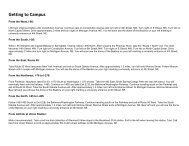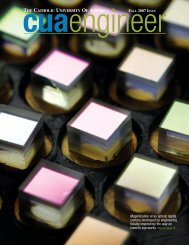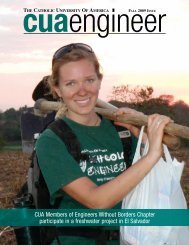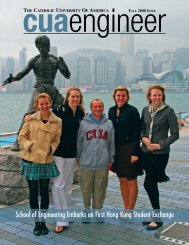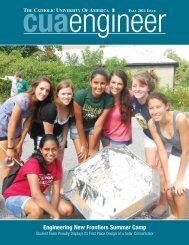inside - the School of Engineering - The Catholic University of America
inside - the School of Engineering - The Catholic University of America
inside - the School of Engineering - The Catholic University of America
You also want an ePaper? Increase the reach of your titles
YUMPU automatically turns print PDFs into web optimized ePapers that Google loves.
NSWC Carderock Offsite Program Counts Its Successes<br />
With nine graduates and 10 students on <strong>the</strong>ir<br />
way to graduation within two to three years,<br />
<strong>the</strong> Department <strong>of</strong> Electrical <strong>Engineering</strong> and<br />
Computer Science (EE&CS) is pleased to report<br />
on <strong>the</strong> success <strong>of</strong> an <strong>of</strong>f-site graduate program<br />
at <strong>the</strong> Naval Surface Warfare Center (NSWC),<br />
Carderock Division. Founded by Associate<br />
Pr<strong>of</strong>essor Mark Mirotznik in 2002, <strong>the</strong> program<br />
<strong>of</strong>fers a series <strong>of</strong> graduate-level courses leading<br />
to a master’s degree in electrical engineering. All<br />
courses required for <strong>the</strong> program — typically<br />
three to four per year — are <strong>of</strong>fered at NSWC’s<br />
West Be<strong>the</strong>sda location, formerly known as <strong>the</strong><br />
David Taylor Model Basin, and taught primarily<br />
by full-time CUA faculty. To ensure that program<br />
<strong>of</strong>ferings are timely and relevant to <strong>the</strong> Navy,<br />
course subjects are selected in consultation with<br />
NSWC management. This strategy <strong>of</strong> <strong>of</strong>fering<br />
convenient and well-targeted graduate courses<br />
has been well received by <strong>the</strong> NSWC employees<br />
and management. Hea<strong>the</strong>r Halberg, a soon-to-be<br />
graduate <strong>of</strong> <strong>the</strong> program, says, “It is so convenient<br />
to just take a short, two-minute walk to my<br />
classes and not have to deal with <strong>the</strong> rush hour<br />
D.C. traffic. It is also great to have real full-time<br />
instructors come to where I work to teach <strong>the</strong><br />
courses. This is much better than <strong>the</strong> online or<br />
video-based alternatives.”<br />
A pleasant side effect <strong>of</strong> <strong>the</strong> master’s level<br />
program has been <strong>the</strong> number <strong>of</strong> graduates who<br />
are now pursuing Ph.D.’s at CUA as a result <strong>of</strong><br />
this <strong>of</strong>fsite program — currently five. Its success<br />
buoys <strong>the</strong> hope that <strong>the</strong> NSWC program will serve<br />
as a model for future <strong>of</strong>f-site graduate programs<br />
at both government and non-government sites<br />
in <strong>the</strong> area.<br />
New Center to Conduct Interdisciplinary Remote Imaging<br />
and Sensing Research<br />
Ozlem Kilic, Ph.D., IRIS director<br />
Don’t let <strong>the</strong> name fool you. Its acronym is IRIS,<br />
but its mission has nothing to do with flowers.<br />
IRIS is <strong>the</strong> Interdisciplinary Remote Imaging and<br />
Sensing Research Center, which was founded<br />
in January 2006 by <strong>the</strong> <strong>School</strong> <strong>of</strong> <strong>Engineering</strong> to<br />
promote research on new remote imaging and<br />
sensing technology, applications and teaching.<br />
<strong>The</strong> center is based on a proposal submitted<br />
to Dean Charles Nguyen by Ozlem Kilic, assistant<br />
pr<strong>of</strong>essor <strong>of</strong> electrical engineering and computer<br />
science, and several o<strong>the</strong>r CUA faculty members.<br />
O<strong>the</strong>r IRIS members include Fred Bruhweiler,<br />
pr<strong>of</strong>essor <strong>of</strong> physics; Poul Lade, pr<strong>of</strong>essor <strong>of</strong> civil<br />
engineering; Mark Mirotznik, associate pr<strong>of</strong>essor <strong>of</strong><br />
electrical engineering and computer science; Nader<br />
Namazi, pr<strong>of</strong>essor <strong>of</strong> electrical engineering and<br />
computer science; Frank (Hsien Ping) Pao, pr<strong>of</strong>essor<br />
<strong>of</strong> civil engineering; and Phillip Regalia, pr<strong>of</strong>essor <strong>of</strong><br />
electrical engineering and computer science.<br />
Since its establishment, <strong>the</strong> research center<br />
has collaborated with o<strong>the</strong>r U.S. and international<br />
institutions on two proposals to <strong>the</strong> National<br />
Science Foundation.<br />
<strong>The</strong> multidisciplinary nature <strong>of</strong> <strong>the</strong> center allows<br />
it to provide research on a variety <strong>of</strong> issues:<br />
disaster management, pollution and contamination<br />
detection and monitoring, land use monitoring and<br />
planning, spatial/statistical analysis and modeling,<br />
and water resource monitoring. <strong>The</strong> center also<br />
will address high-demand military applications<br />
such as target identification, clutter reduction, mine<br />
detection and through-wall sensing.<br />
<strong>The</strong> current and future activities <strong>of</strong> <strong>the</strong> center<br />
include:<br />
■ Joint applications for research funding by<br />
center members with diverse interests.<br />
■ Establishing partnerships with government<br />
laboratories and industry on research,<br />
development and teaching activities.<br />
■ Attracting scientists as guest lecturers or<br />
visiting faculty.<br />
■ Organizing workshops in <strong>the</strong> United<br />
States and internationally.<br />
■ Enabling internships for students at government<br />
or private-industry laboratories;<br />
■ Creating and maintaining a Web site to<br />
promote ongoing research activities.<br />
IRIS intends to:<br />
■ Attract visitors, scholars and prospective<br />
students.<br />
■ Draw on CUA’s proximity to federal<br />
agencies such as NASA, <strong>the</strong> Department<br />
<strong>of</strong> Agriculture, <strong>the</strong> National Science<br />
Foundation and <strong>the</strong> Department <strong>of</strong><br />
Defense, which would have a keen interest<br />
in <strong>the</strong> center’s research areas.<br />
■ Facilitate collaboration with o<strong>the</strong>r local<br />
research institutions and universities.<br />
<strong>The</strong> center is actively seeking research funding<br />
and collaborative partnerships to establish itself<br />
as a self-sufficient entity.<br />
For additional information about <strong>the</strong> center,<br />
contact Ozlem Kilic by e-mail at kilic@cua.edu<br />
or by phone at 202-319-5261.<br />
fall2006 | 15



